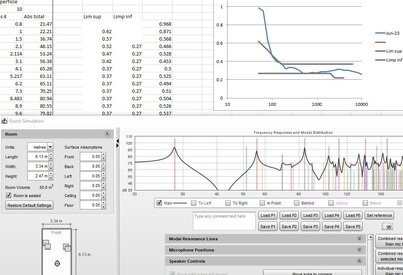Nordo
Member
More
- Preamp, Processor or Receiver
- Crappy Samsung HW-Q950T Soundbar
- Universal / Blu-ray / CD Player
- Panasonic BD35; Panasonic DP-UB820
- Streaming Equipment
- TP-Link Archer AX55 and Hisense 65Q8
- Streaming Subscriptions
- Netflix
- Front Height Speakers
- -
- Rear Height Speakers
- -
- Video Display Device
- Hisense 65Q8
I've been dabbling with the Room Sim section of REW.
I did a search for "surface absorption coefficients" to ascertain what coeffs I should be putting in for the various surfaces.
In the Help section of REW, it states that the surface absorption is "independent of angle or frequency".
However all information I found regarding surface absorption indicates that the absorption coefficient IS frequency dependent.
Can John or anyone throw some light on this?
In my case the walls are timber framed with plasterboard (drywall) on both sides, and the ceiling is timber framed with plasterboard on the lower face.
The floor is a carpeted concrete slab.
BTW, I have recently realised that lightweight walls, like I am looking at, become almost transparent below certain frequencies.
i.e. the LF wave velocity is NOT zero at the wall face. Which questions some of the theory behind bass traps.
I did a search for "surface absorption coefficients" to ascertain what coeffs I should be putting in for the various surfaces.
In the Help section of REW, it states that the surface absorption is "independent of angle or frequency".
However all information I found regarding surface absorption indicates that the absorption coefficient IS frequency dependent.
Can John or anyone throw some light on this?
In my case the walls are timber framed with plasterboard (drywall) on both sides, and the ceiling is timber framed with plasterboard on the lower face.
The floor is a carpeted concrete slab.
BTW, I have recently realised that lightweight walls, like I am looking at, become almost transparent below certain frequencies.
i.e. the LF wave velocity is NOT zero at the wall face. Which questions some of the theory behind bass traps.
















